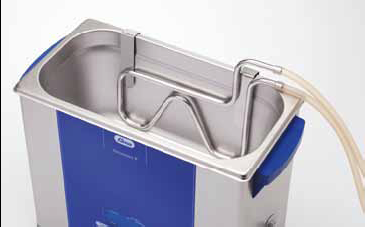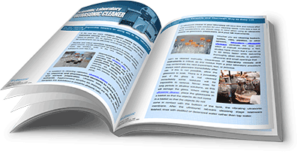Maximize Performance of your Ultrasonic Bath

If you have invested in an ultrasonic bath you have an appreciation of how these units contribute to fast, safe and efficient removal of contaminants from virtually any product that can be safely wetted in a biodegradable ultrasonic bath. In this post we provide recommendations on maximizing the performance of your ultrasonic bath, thereby contributing to the efficiency of your ultrasonic cleaning operations.
Points covered include:
- Selecting the correct cleaning bath chemistry
- Cleaning time and cleaning temperature
- Tips on extending the effective life of ultrasonic baths
Ultrasonic Cleaning Bath Chemistry
There is a wide variety of formulations available to support ultrasonic cleaning operations. Some manufacturers term these ultrasonic cleaning solutions, others use an overall category called soaps. One can’t argue with that because using soaps conjures up images of cleaning, whether in the car wash, clothes washer or shower.
Regardless of nomenclature, these formulations are designed to perform specific cleaning tasks. Rather than take your time to describe these in this post, please visit our post on how to select an ultrasonic cleaning solution.
Ultrasonic Cleaner Bath Time and Temperature
Manufacturers of ultrasonic cleaning bath formulations provide instructions on recommended dilutions with water and suggested cleaning temperatures.
Ultrasonic Cleaning Time
Cleaning time depends on your personal experience in using these units. Our ultrasonic blog posts get into detail on specific cleaning operations, and we invite you to visit the various posts. Cleaning time can be controlled by timers found on many models including the Elmasonic ultrasonic cleaners offered by Tovatech.
Ultrasonic Cleaning Temperature
Cleaning temperature is another matter. Recommended ultrasonic bath temperatures are provided by suppliers of cleaning solution concentrates. Generally warm baths do a better job but in many cases too much heat can damage items being cleaned.
The temperature at which an ultrasonic cleaner bath is at maximum effectiveness is usually included in the detail sheets or specified by standard operating procedures provided by technical and trade associations.
As examples the product information sheet for the widely used alkaline elma tec clean A4 suggests temperatures of 50 to 80⁰C whereas MedClean C7 for dental and surgical instruments should be used at approximately 40⁰C.
High ultrasonic bath temperatures are generally recommended for parts heavily contaminated by grease and oils but can cause blood to strongly bond on dental and surgical instruments. In general, however, the effectiveness of ultrasonic cleaning solution temperature levels off at approximately 80⁰C above which all you are doing is wasting electricity.
Ultrasonic cleaning equipment such as the Elma E, S and P series available from Tovatech are equipped with heaters that allow users to select the recommended cleaning temperature. These units are equipped with an auto-start function that will initiate cavitation when the selected cleaning solution temperature is reached, at which time the heater switches off.
Ultrasonic Cavitation Produces Heat
It is important to understand that ultrasonic cavitation energy is transformed to heat during the cleaning process even if the unit’s heater is turned off. A continually operating unit can raise solution temperature as high as 60⁰C depending on the model.
Ultrasonic Bath Temperature Cooling
If you are cleaning products where temperature increases must be limited you should implement a method to cool the solution.
Tovatech offers the Elma cooling coil that is attached to cleaning bath. Cooling water is circulated through the coil to prevent overheating of the cleaning liquid.
The cooling coil can be easily mounted into any of the P ultrasonic cleaner units available from Tovatech. Little time is needed to fit it into the tank between the basket and the tank wall. For larger tanks, two or more cooling coils can be combined. The cooling coil is connected to a customer-provided laboratory cryostat or to the tap water system.
You can also build your own system. A customer using the Elmasonic P60H unit to clean vinyl phonograph records activates a pump when the solution temperature nears 50⁰C. The pump moves the liquid from the tank drain through a tube and a 1 micron filter from which it is returned to the tank. This, the customer says, both cools and cleans the solution.
The takeaway here is to pay attention to the temperature of your ultrasonic cleaning bath if high temperatures either impede the cleaning process (such as surgical instrument cleaning) or can damage the objects being cleaned.
How to Extend the Life of your Ultrasonic Cleaner Bath
Grease, dirt and other contamination removed during the ultrasonic cleaning process end up in the bath. Removing them helps you extend bath life. This is especially important when using large-capacity industrial ultrasonic cleaners.
For some operations replacement time is signaled by visibly dirty solutions and longer cleaning cycles. In others, notably the removal of grease and oils, it is evidenced by oils rising and floating on the surface. Not as evident are contaminants that settle to the bottom of the tank.
Ultrasonic cleaning baths can be specified based on how you deal with grease and oils. In these instances they are classified as emulsifying and demulsifying cleaners. In the former instance oils remain suspended in the cleaning solution where they eventually inhibit efficiency and must be replaced.
In the latter they rise to the surface and can be skimmed off and set aside for later disposal.
Larger ultrasonic cleaner tanks are available with a skimming ledge that channels floating contaminants into a holding tank for proper disposal. If an emulsifying cleaning solution is used in industrial-sized units an option is to connect an oil separator to the equipment. The bath is circulated through the separator where suspended oil is removed and the treated solution returned.
Filters are available to extend ultrasonic cleaning bath life. These can quickly pay for themselves when used on large capacity units. The best are dual-filter systems that first remove particles that cause wear on the pump while the second removes smaller contaminants. Filter replacement time is signaled by a pressure gauge.
Regardless of how you extend the life of your ultrasonic cleaning bath you must include tank cleaning as part of the maintenance procedure. Follow the manufacturer’s recommendations and in no case use an abrasive when removing sediments on the bottom of the tank.
We hope this post is helpful in selecting, using and maintaining an ultrasonic cleaner bath. Please contact the ultrasonic cleaning pros at Tovatech for answers to your cleaning challenges and recommendations on the equipment to use.
